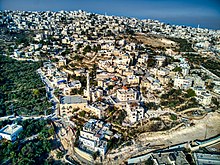
Rafat is a Palestinian town, located approximately 4 km (2.5 mi) southwest of the city of Ramallah in the central West Bank in the northern Jerusalem Governorate. According to the Palestinian Central Bureau of Statistics, it had a population of 2,941 in 2017. Its total land area consists of 3,773 dunams.
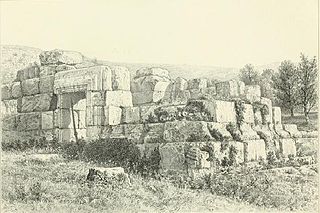
Tayasir is a Palestinian village in the Tubas Governorate of the State of Palestine, in the northern West Bank. It is located 3 kilometers northeast of Tubas and 22 kilometers northeast of Nablus. Nearby localities include al-Aqabah to the east, al-Bikai'a to the northeast, Salhab to the north, 'Aqqaba to the west and ath-Thaghra to the southwest. According to the Palestinian Central Bureau of Statistics (PCBS), Tayasir had a population of 2,489 in 2007 and a population of 2,878 by 2017.

Sur Baher, also Tsur Baher, is a Palestinian neighborhood on the southeastern outskirts of East Jerusalem. It is located east of Ramat Rachel and northeast of Har Homa. In 2006, Sur Baher had a population of 15,000.
'Aqqaba is a Palestinian town located on a slope in the Jordan Valley in the northern West Bank, 15 kilometers northeast of Jenin in the Tubas Governorate of the State of Palestine. According to the Palestinian Central Bureau of Statistics (PCBS), the town had a population of 8,239 inhabitants in the 2017 census.

Beit Iba is a Palestinian village in the Nablus Governorate in the North central West Bank, located 7 kilometers northwest of Nablus. According to the Palestinian Central Bureau of Statistics (PCBS), the village had a population of 4,079 inhabitants in 2017.
Kafr Laqif is a Palestinian village in the Qalqilya Governorate in the western West Bank, located 22 kilometers southwest of Nablus. According to the Palestinian Central Bureau of Statistics, the village had a population of 1,039 inhabitants in 2017.

Iskaka is a Palestinian town in the Salfit Governorate of the State of Palestine, in the northern West Bank, 27 kilometers southwest of Nablus. According to the Palestinian Central Bureau of Statistics, it had a population of 1,198 in 2017.
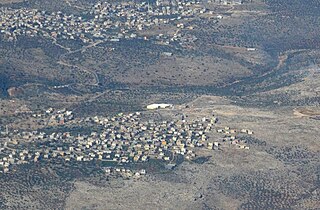
Rafat is a Palestinian town in the Salfit Governorate of the State of Palestine, in the northern West Bank, 38 kilometers southwest of Nablus. According to the Palestinian Central Bureau of Statistics, it had a population of 2,522 in 2017.
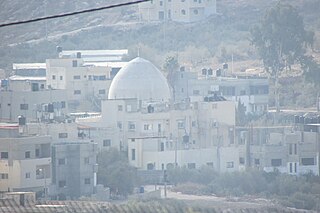
Deir Sharaf is a Palestinian town in the Nablus Governorate in northern West Bank, located northwest of Nablus. According to the Palestinian Central Bureau of Statistics (PCBS), the town had a population of 2,949 inhabitants in 2017.

Qusin is a Palestinian town in the Nablus Governorate in northern West Bank, located 8 kilometers West of Nablus. According to the Palestinian Central Bureau of Statistics (PCBS), the town had a population of 2,251 inhabitants in 2017.
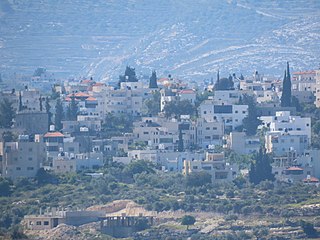
Saffa is a Palestinian town in the Ramallah and al-Bireh Governorate, located west of Ramallah in the northern West Bank. According to the Palestinian Central Bureau of Statistics (PCBS), the town had a population of 4,374 inhabitants in 2017.

Deir as-Sudan is a Palestinian town in the Ramallah and al-Bireh Governorate, located 20 kilometers Northwest of Ramallah in the northern West Bank. According to the Palestinian Central Bureau of Statistics (PCBS), the town had a population of approximately 2,159 inhabitants in 2017.

Surda is a Palestinian town in the Ramallah and al-Bireh Governorate, located northeast of Ramallah in the northern West Bank. According to the Palestinian Central Bureau of Statistics (PCBS), the town had a population of 1,308 inhabitants in 2017.
Ar-Rihiya is a Palestinian town located six kilometers southwest of Hebron. The town is in the Hebron Governorate southern West Bank. According to the Palestinian Central Bureau of Statistics, the town had a population of over 5,754 in 2017.

Burham is a Palestinian village in the Ramallah and al-Bireh Governorate located twelve kilometers north of Ramallah. The largest nearby town is Bir Zeit located to the southeast. The average elevation of Burham is 680 meters above sea level. The village was established during the Byzantine Empire rule over Palestine.

Kharbatha Bani Harith is a Palestinian village in the central West Bank, located 15 kilometers west of Ramallah in the Ramallah and al-Bireh Governorate. According to the Palestinian Central Bureau of Statistics, the village had a population of 3,471 in 2017. It has a total land area of 7,120 dunams.

Shabtin is a Palestinian village in the Ramallah and al-Bireh Governorate of the State of Palestine, in the central West Bank.
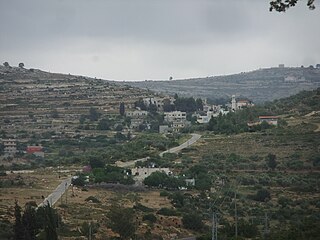
Umm Safa/Kafr Ishwa or Um Al-Safa is a Palestinian village in the Ramallah and al-Bireh Governorate.
Jibiya is a Palestinian village in the Ramallah and al-Bireh Governorate. It was founded after the 16th century. It is mentioned in text from 1697.
At-Tira is a Palestinian village in the Ramallah and al-Bireh Governorate in the northern West Bank.
